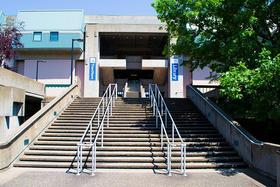School Highlights
Gateway Technical College serves 14,215 students (10% of students are full-time).
The college's student-teacher ratio of 19:1 is higher than the state community college average of 16:1.
Minority enrollment is 43% of the student body (majority Hispanic), which is more than the state average of 35%.
Quick Facts (2025-26)
- Enrollment: 14,215 students
- In-state tuition: $4,009
- Out-state tuition: $5,898
- Acceptance Rate: 91%
- Student-teacher ratio: 19:1
- Minority enrollment: 43%
- Source: Integrated Postsecondary Education Data System (IPEDS)
Top Rankings
Gateway Technical College ranks among the top 20% of public schools in Wisconsin for:
Category
Attribute
Community Size
School Overview
The teacher population of 761 teachers has stayed relatively flat over five years.
Gateway Technical College
(WI) Community College Avg.
Carnegie Classification
Associate's Colleges: High Career & Technical-Mixed Traditional/Nontraditional
Associate's Colleges: High Career & Technical-Mixed Traditional/Nontraditional
Institution Level
At least 2 but less than 4 years
At least 2 but less than 4 years
Institution Control
Public
Public
Total Faculty
761 staff
419 staff
School Calendar
Student Body
The student population of Gateway Technical College has grown by 41% over five years.
The student-teacher ratio of 19:1 has increased from 10:1 over five years.
The Gateway Technical College diversity score of 0.61 is more than the state average of 0.55. The school's diversity has grown by 7% over five years.
Total Enrollment
14,215 students
5,183 students
Student-Teacher Ratio
19:1
16:1
# Full-Time Students
1,405 students
798 students
# Part-Time Students
12,810 students
4,385 students
# Enrollment Undergraduate
142 students
373 students
# Full-Time Undergraduate Students
1,405 students
798 students
# Full-Time Graduate Students
n/a
27 students
# Part-Time Undergraduate Students
12,810 students
4,624 students
# Part-Time Graduate Students
n/a
15 students
Total Dormitory Capacity
n/a
148 students
% American Indian/Alaskan
n/a
1%
% Asian
2%
4%
% Hispanic
23%
10%
% Black
9%
9%
% White
57%
65%
% Hawaiian
n/a
n/a
% Two or more races
4%
3%
% Non Resident races
n/a
n/a
% Unknown races
5%
8%
Diversity Score
0.61
0.55
College Completion Rate (Students who graduate in less than 4 years)
45%
48%
College Completion Rate (Students who graduate in 4 years or more than 4 years)
n/a
22%
Average Graduate Earnings (10 Years)
$33,200
$34,300
Tuition and Acceptance Rate
The public in-state tuition of $4,009 is less than the state average of $4,194. The in-state tuition has declined by 13% over four years.
The public out-state tuition of $5,898 is less than the state average of $6,373. The out-state tuition has declined by 12% over four years.
In-State Tuition Fees
$4,009
$4,194
Out-State Tuition Fees
$5,898
$6,373
% Students Receiving Some Financial Aid
58%
76%
Median Debt for Graduates
$12,250
$11,250
Median Debt for Dropouts
$6,666
$5,500
Acceptance Rate
91%
88%
ACT Composite
n/a
21
ACT English
n/a
19
ACT Math
n/a
20
Source: 2024 (or latest year available) Integrated Postsecondary Education Data System (IPEDS)
School Notes
- Gateway has a rich and proud heritage in local and national career training education. Original state legislation establishing adult and technical education was enacted in 1911. The first technical school in Wisconsin, the nation's first publicly supported technical institution, began that same year in downtown Racine as the name predecessor to Gateway Technical College. A state- sanctioned technical school opened in Kenosha in 1912. Kenosha County established the first Vocational, Technical and Adult Education District under state law in 1965, which allowed district formation beyond city limits on July 1, 1966. Walworth County joined the Kenosha District in 1967 to form District 6, and the City of Racine expanded services on July 1, 1967, to include Racine County. On July 1, 1971, a new Vocational, Technical and Adult Education District 6 was formed, comprised of Kenosha, Racine, and Walworth Counties. In 1994 the state technical district system became the Wisconsin Technical College System. The name "Gateway" was adopted October 19, 1972, by the District Board for the Gateway District, replacing reference to District 6, with campuses at Elkhorn, Kenosha, and Racine. As was the case in 1911, Gateway today continues to meet the need for skilled workers in technical-oriented fields. Gateway offers instructional programs from its campuses and through distance learning opportunities, such as online courses, to approximately 29,000 students annually. The Kenosha Campus features 27 Associate Degree options, as well as numerous Advanced Technical Diplomas and Gateway certificates. The Kenosha Campus was proud to introduce its Health Career Labs, utilizing state of the art learning equipment, including the first Patient Simulator of its kind in Southeastern Wisconsin. The computer-operated Simulator allows students to react to real-world medical issues with the consequences of their actions simulated by the equipment. Numerous health career training options are available on the Kenosha Campus. All Gateway sites in Kenosha , Racine and Walworth Counties are fully accredited by the Higher Learning Commission of North Central Association of Colleges and Schools.
- Sample of notable school alumni/alumnae:
- Carly Hawkins, Liberal Arts graduate, transferred to a four-year college. -
Frequently Asked Questions
How much does Gateway Technical College cost?
Gateway Technical College's tuition is approximately $4,009 for In-State students and $5,898 for Out-State students.
What schools are Gateway Technical College often compared to?
Gateway Technical Collegeis often viewed alongside schools like Herzing University Kenosha by visitors of our site.
What is the acceptance rate of Gateway Technical College?
The acceptance rate of Gateway Technical College is 91%, which is higher than the state average of 88%.
Who are famous alumni from Gateway Technical College?
Gateway Technical College famous alumni include: Carly Hawkins, Liberal Arts graduate, transferred to a four-year college..
What is Gateway Technical College's ranking?
Gateway Technical College ranks among the top 20% of community college in Wisconsin for: Largest student body.
Recent Articles

The Rise of Technical and Vocational Training in 2025
Explore the 2025 surge in technical and vocational training—enrollment, policy, costs, and why this path is gaining ground for students and parents.

Stackable Credentials: How Community Colleges Advance Careers
Discover how community colleges use stackable credentials to build career pathways, boost earnings, and enable lifelong learning in 2025.

High-Paying Jobs You Can Get with a Community College Degree
Discover top high-paying careers you can launch in 2025 with a community college (associate) degree and high-growth credentials in tech, healthcare and trades.









